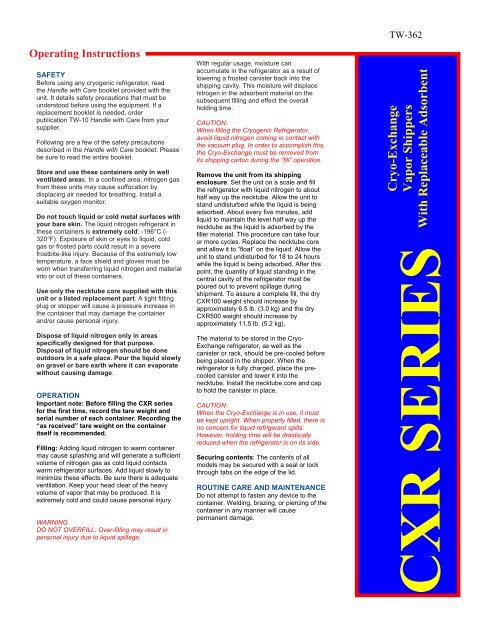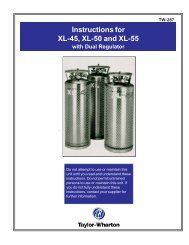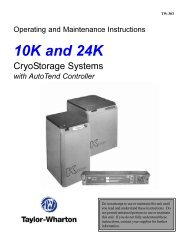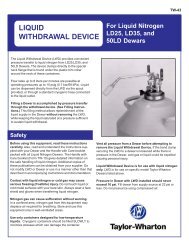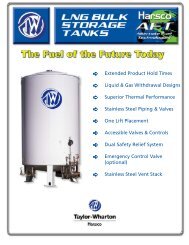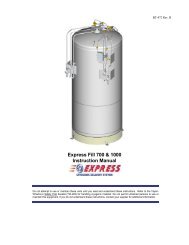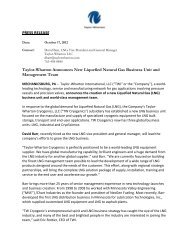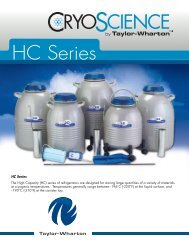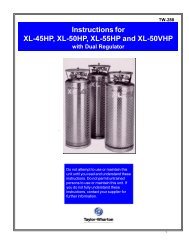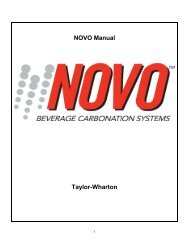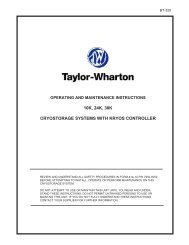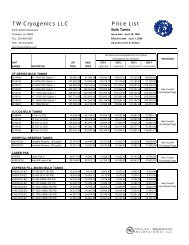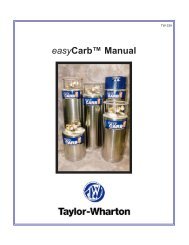CXR100 & CXR500 - Taylor-Wharton
CXR100 & CXR500 - Taylor-Wharton
CXR100 & CXR500 - Taylor-Wharton
You also want an ePaper? Increase the reach of your titles
YUMPU automatically turns print PDFs into web optimized ePapers that Google loves.
Operating InstructionsSAFETYBefore using any cryogenic refrigerator, readthe Handle with Care booklet provided with theunit. It details safety precautions that must beunderstood before using the equipment. If areplacement booklet is needed, orderpublication TW-10 Handle with Care from yoursupplier.Following are a few of the safety precautionsdescribed in the Handle with Care booklet. Pleasebe sure to read the entire booklet.Store and use these containers only in wellventilated areas. In a confined area, nitrogen gasfrom these units may cause suffocation bydisplacing air needed for breathing. Install asuitable oxygen monitor.Do not touch liquid or cold metal surfaces withyour bare skin. The liquid nitrogen refrigerant inthese containers is extremely cold: -196°C (-320°F). Exposure of skin or eyes to liquid, coldgas or frosted parts could result in a severefrostbite-like injury. Because of the extremely lowtemperature, a face shield and gloves must beworn when transferring liquid nitrogen and materialinto or out of these containers.Use only the necktube core supplied with thisunit or a listed replacement part. A tight fittingplug or stopper will cause a pressure increase inthe container that may damage the containerand/or cause personal injury.Dispose of liquid nitrogen only in areasspecifically designed for that purpose.Disposal of liquid nitrogen should be doneoutdoors in a safe place. Pour the liquid slowlyon gravel or bare earth where it can evaporatewithout causing damage.OPERATIONImportant note: Before filling the CXR seriesfor the first time, record the tare weight andserial number of each container. Recording the“as received” tare weight on the containeritself is recommended.Filling: Adding liquid nitrogen to warm containermay cause splashing and will generate a sufficientvolume of nitrogen gas as cold liquid contactswarm refrigerator surfaces. Add liquid slowly tominimize these effects. Be sure there is adequateventilation. Keep your head clear of the heavyvolume of vapor that may be produced. It isextremely cold and could cause personal injuryWARNINGDO NOT OVERFILL. Over-filling may result inpersonal injury due to liquid spillage.With regular usage, moisture canaccumulate in the refrigerator as a result oflowering a frosted canister back into theshipping cavity. This moisture will displacenitrogen in the adsorbent material on thesubsequent filling and effect the overallholding time.CAUTION:When filling the Cryogenic Refrigerator,avoid liquid nitrogen coming in contact withthe vacuum plug. In order to accomplish this,the Cryo-Exchange must be removed fromits shipping carton during the “fill” operation.Remove the unit from its shippingenclosure. Set the unit on a scale and fillthe refrigerator with liquid nitrogen to abouthalf way up the necktube. Allow the unit tostand undisturbed while the liquid is beingadsorbed. About every five minutes, addliquid to maintain the level half way up thenecktube as the liquid is adsorbed by thefiller material. This procedure can take fouror more cycles. Replace the necktube coreand allow it to “float” on the liquid. Allow theunit to stand undisturbed for 18 to 24 hourswhile the liquid is being adsorbed. After thispoint, the quantity of liquid standing in thecentral cavity of the refrigerator must bepoured out to prevent spillage duringshipment. To assure a complete fill, the dry<strong>CXR100</strong> weight should increase byapproximately 6.5 lb. (3.0 kg) and the dry<strong>CXR500</strong> weight should increase byapproximately 11.5 lb. (5.2 kg).The material to be stored in the Cryo-Exchange refrigerator, as well as thecanister or rack, should be pre-cooled beforebeing placed in the shipper. When therefrigerator is fully charged, place the precooledcanister and lower it into thenecktube. Install the necktube core and capto hold the canister in place.CAUTION:When the Cryo-Exchange is in use, it mustbe kept upright. When properly filled, there isno concern for liquid refrigerant spills.However, holding time will be drasticallyreduced when the refrigerator is on its side.Securing contents: The contents of allmodels may be secured with a seal or lockthrough tabs on the edge of the lid.ROUTINE CARE AND MAINTENANCEDo not attempt to fasten any device to thecontainer. Welding, brazing, or piercing of thecontainer in any manner will causepermanent damage.TW-362Cryo-ExchangeVapor ShippersWith Replaceable Adsorbent
Refrigeration depends on the presence of liquid nitrogen refrigerant inthe refrigerator. Be sure to maintain a full charge of refrigerant toprevent loss of stored materials. Please refer to the “Operations”section of this document for instructions on the filling procedure. If youare not able to fully charge the Cryo-Exchange unit by weight, it ispossible that moisture has accumulated in the filler material over timewith normal usage. This accumulation will result in displacement ofrefrigerant. Direct dry heat not to exceed 150 o F (65 o C) (from a hairdryer or other source) into the refrigerator. The unit is acceptably drywhen the tare weight is within 1 lb. (0.45 kg) of the “as received fromthe manufacturer” tare weight. If the tare weight is still not satisfactory,or contamination is suspected, a new set of adsorbent socks can bepurchased to bring the unit back to factory specifications.REPLACING THE ADSORBENTTW-362TRANSPORTATIONAlthough these refrigerators are rugged, they can be damaged ifabused or otherwise mishandled. A specially designed hard-shellshipping container (refer to the parts section for ordering information)should be used anytime the refrigerator is transported. This containerwill help prolong the life of the unit and should be replaced if damagedduring use. When moving or transporting a refrigerator, take everyprecaution to prevent sliding, tipping, bumping, or dropping the unit.Keep the unit upright. Although there is no safety hazard if theproperly filled refrigerator is on its side, the refrigerant consumption ismuch greater with the unit in this position and holding time will besignificantly reduced.RETURNSManufacturing defects are covered under the containers limitedwarranty. Evidence of mishandling, such as dents on the outer vessel,or misalignment of the inner vessel, are not manufacturing defects. Ifhigh evaporation rates are apparent under normal operatingconditions, the refrigerator may be losing its vacuum. Sweating andthe formation of frost on the outer casing are indications therefrigerator may be losing its vacuum. All necessary steps should betaken to protect the refrigerator’s contents. Please contact yoursupplier for information on how to conduct a normal evaporation rate(NER) test in the field.If you would like to return goods to <strong>Taylor</strong>-<strong>Wharton</strong> for any reason, youmust first obtain a Material Return Authorization (MRA) number fortracking purposes. Please have a description of your symptoms andyour serial number ready. Contact your supplier or call us at 1-800 TWTANKS ore-mail us at cryotanks@taylorwharton.com.FIGURE 1.0REPLACEMENT PARTSDescription <strong>CXR100</strong> <strong>CXR500</strong>Handle <strong>CXR100</strong>-6C12 N/AHandle, Pin 8631-5000 N/ACanister <strong>CXR100</strong>-9C24 Note*Neckplug Assembly <strong>CXR100</strong>-9C16 CP70-9C18Core Sleeve <strong>CXR100</strong>-9C20 <strong>CXR500</strong>-9C20Adsorbent Sock (Set) <strong>CXR100</strong>-9C30<strong>CXR100</strong>-9C30(2 Sets)Decal <strong>CXR100</strong>-9C25 <strong>CXR500</strong>-9C25Hard Shell Shipping Enclosure CX10-8C00 CP19-8C00Padded Carton Shipping Enclosure 3701-9277 N/AA) On a clean working surface in a well ventilated area and theCXR at ambient temperature, begin by removing the capassembly and canister (items 1 and 2) shown above in figure1.0.B) Wearing gloves made from one of the following:polyethylene/ethylene vinyl alcohol, polyvinyl alcohol, Teflonor Viton, reach down the necktube and remove the core(item 3).C) Reach in and remove one at a time the 7 adsorbent socks(item 4). Dispose of the used socks properly.D) Clean the empty CXR (item 5) with an approved disinfectant,and then dry thoroughly.E) Replace the Adsorbent socks with TW part number <strong>CXR100</strong>-9C30. Place the socks down the necktube standing themvertically around the perimeter of the CXR.F) Replace the Core (item 3)G) Fill the CXR per the procedure found in the operation sectionof this manual.Note*: Five shelf rack (for TW plastic box)…………RS30-9C40Blood Bag Rack……………………………………….CP70-9C44
4075 Hamilton Blvd.Theodore, Alabama 36582 U.S.A.Telephone (251) 443-8680Fax (251) 443-2250In U.S. and Canada:(800) TW TANKS (898-2657)©2002 Harsco CorporationTW-362


